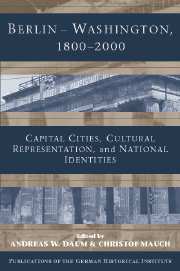Book contents
- Frontmatter
- PART I CITIES AS CAPITALS ON A GLOBAL SCALE
- PART II THE CAPITAL IN THE NATION
- 2 Siting Federal Capitals: The American and German Debates
- 3 Written Capitals and Capital Topography: Berlin and Washington in Travel Literature
- 4 Prime Meridians, National Time, and the Symbolic Authority of Capitals in the Nineteenth Century
- 5 Washington and Berlin: National Capitals in a Networked World
- PART III ARCHITECTURE, MEMORY, SPACE
- PART IV POLITICAL POWER AND CAPITAL FUNCTIONS
- Index
3 - Written Capitals and Capital Topography: Berlin and Washington in Travel Literature
Published online by Cambridge University Press: 05 January 2013
- Frontmatter
- PART I CITIES AS CAPITALS ON A GLOBAL SCALE
- PART II THE CAPITAL IN THE NATION
- 2 Siting Federal Capitals: The American and German Debates
- 3 Written Capitals and Capital Topography: Berlin and Washington in Travel Literature
- 4 Prime Meridians, National Time, and the Symbolic Authority of Capitals in the Nineteenth Century
- 5 Washington and Berlin: National Capitals in a Networked World
- PART III ARCHITECTURE, MEMORY, SPACE
- PART IV POLITICAL POWER AND CAPITAL FUNCTIONS
- Index
Summary
There is an old saying that cities can be perceived as books. The German author Ludwig Boerne wrote in the early nineteenth century: “Paris can be called an open book - wandering through its streets is reading.” Franz Hessel, wandering through Berlin in the 1920s, gives the same metaphor a more precise meaning: “Flanerie is a way of reading the streets, where people's faces, shops, window displays, outdoor cafes, cars, tracks and trees become a series of letters, which together form the words, sentences, and pages of a book that is always new.”
The metaphor of “reading cities like books” has always appealed to writers and readers because it turns the city experience into a refined intellectual activity. The world as an “open book” is among the most venerable metaphors in the Western literary tradition. Travel literature is thus not only something for a reader to experience but also source material for historians. This metaphor is especially appealing to literary critics, who are accustomed to reading texts and feel at home reading texts about texts. It offers them an account of what might be going on when one looks at and wanders through cities.
What does it mean to read a city? One might turn to semiotic theory. Roland Barthes, for example, suggests in his essay “Semiology and Urbanism” that to read a city like a script that has to be deciphered, you must have in mind the task of structuralism: breaking down the city text into discrete units, arranging them alongside their opposite meanings, and then looking for the signs and signifiers that actually load the city with meanings. And that is how a city is to be read. The signifiers point to signified meanings that might be changing – or, in modern cities, that change constantly. The signifiers may rise to new meanings, the order of signs may be disturbed, the signs may be ambiguous or contradictory. The signs may always be in danger of being transitory or of being destroyed, but while a city has an abundance of signs (buildings, streets, and squares, for example), the meanings of these signs change over time. “The signifieds pass, the signifiers remain.” Moreover, a city changes its meaning not only in the content of its signs, but also in the relation of its parts. There are more texts in a city than one reader may see, and there are cities within a city arising from travelers’ different readings. Taking the process and the phenomenology of reading into consideration, it is clear that readers (and travelers) always write their own texts. The book that a city is supposed to be depends on how its readers fill the pages. There is no city and no capital – apart from the actual and historical readings to which they are subject.
- Type
- Chapter
- Information
- Berlin - Washington, 1800–2000Capital Cities, Cultural Representation, and National Identities, pp. 51 - 78Publisher: Cambridge University PressPrint publication year: 2005
- 1
- Cited by



